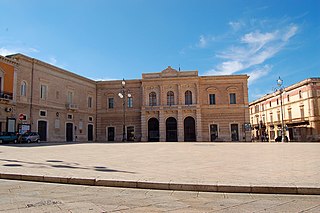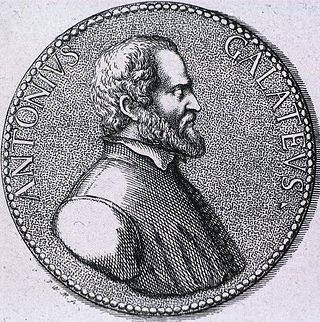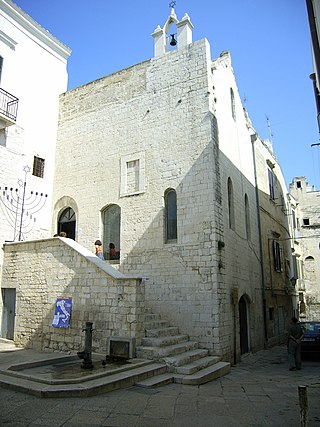
Apulia, also known by its Italian name Puglia, is a region of Italy, located in the southern peninsular section of the country, bordering the Adriatic Sea to the east, the Strait of Otranto and Ionian Sea to the southeast and the Gulf of Taranto to the south. The region comprises 19,345 square kilometers (7,469 sq mi), and its population is about four million people. It is bordered by the other Italian regions of Molise to the north, Campania to the west, and Basilicata to the southwest. The regional capital is Bari.

Otranto is a coastal town, port and comune in the province of Lecce, in a fertile region once famous for its breed of horses. It is one of I Borghi più belli d'Italia.

Brindisi is a city in the region of Apulia in southern Italy, the former capital of the province of Brindisi, on the coast of the Adriatic Sea. Historically, the city has played an essential role in trade and culture due to its strategic position on the Italian Peninsula and its natural port on the Adriatic Sea. The city remains a major port for trade with the Balkan Peninsula, Greece and the Middle East. Its industries include agriculture, chemical works, and the generation of electricity.

Salento, is a cultural, historical, and geographic region at the southern end of the administrative region of Apulia, in southern Italy. It is a sub-peninsula of the Italian Peninsula, sometimes described as the "heel" of the Italian "boot". It encompasses the entire administrative area of the Province of Lecce, most of the Province of Brindisi, and the south-eastern part of the Province of Taranto.

The province of Brindisi is a province in the Apulia region of Italy. Its capital is the city of Brindisi. It has an area of 1,839 square kilometres (710 sq mi) and a total population of 401,652 (2013).

The province of Lecce is a province in the Apulia region of Italy. Its capital is the city of Lecce. The province is called the "Heel of Italy". Located on the Salento peninsula, it is the second most-populous province in Apulia and the 21st most-populous province in Italy.

Negroamaro is a red wine grape variety native to southern Italy. It is grown almost exclusively in Apulia and particularly in Salento, the peninsula which can be visualised as the "heel" of Italy. The grape can produce wines very deep in color. Wines made from Negroamaro tend to be very rustic in character, combining perfume with an earthy bitterness. The grape produces some of the best red wines of Apulia, particularly when blended with the highly scented Malvasia Nera, as in the case of Salice Salentino.
The music of Apulia has had some glorious history as well as some very hard times. Located along the southern Adriatic, the area was part of Magna Grecia and certainly one of the centers of Ancient Greek music. And 1,000 years ago, Bari, on the coast, was a privileged sanctuary for pilgrims and Crusaders on their way to the Holy Land. Yet, the only musical relic that remains from the period is the Excultet, a representation from the 11th century of two angels playing trumpets that is preserved in the Basilica of San Nicola in Bari. Later, as part of the Kingdom of Naples, Apulia produced many memorable names in music, but like elsewhere in the south, many of them gravitated to Naples, the capital of the kingdom.

Fasano is a town and comune in the Province of Brindisi, Apulia, southern Italy. It is the second most populated town in the province after Brindisi, with a population in 2021 of 39,026.
Ferrovie del Sud Est (FSE) is a railway company in Apulia region, Italy. The company operates in the comuni south of Lecce and in the provinces of Bari, Brindisi and Taranto. The company also operates bus lines. In August 2016 its network was taken over by Ferrovie dello stato due to financial problems at the company. The company is now wholly owned by the Italian Transport Ministry.

The Terra di Bari, in antiquity Peucetia and in the Middle Ages Ager Barianus, is the region around Bari in Apulia. Historically it was one of the justiciarships of the Kingdom of Sicily and later Naples. It became a province in the Two Sicilies. Today it is a part of the Province of Bari in Italy. Since 2005, according to the municipal government of Bari, it refers to the metropolitan area of the city and is trademarked for touristic purposes.
The County of Lecce was a county located in Apulia, in south-eastern Italy, which existed from 1055 until 1463. Its capital was at the city of Lecce, and it was bounded by the territories of Brindisi to the north, Oria and Nardò to the west, and Soleto and Otranto to the south.

Lecce railway station serves the city and comune of Lecce, in the region of Apulia, Southern Italy. Opened in 1866, it is the southern terminus of the Adriatic Railway (Ancona–Lecce), and is also the terminus of two regional lines, the Martina Franca–Lecce railway and the Lecce–Otranto railway.

Antonio de Ferraris, also known by his epithet Galateo, was an Italian scholar, academic, doctor and humanist, of Greek descent.

The history of the Jews in Apulia can be traced back over two thousand years. Apulia in Hebrew:פוליה) is a region in the "heel of the boot" of the peninsula of Italy bordering the Adriatic Sea. The Jews have had a presence in Apulia for at least 2000 years. The Jews of Apulia had a rich Rabbinic tradition and also had a sizeable Jewish population in the central Mediterranean prior to their expulsion.

The Metropolitan City of Bari is a metropolitan city in the Apulia region of Italy. Its capital is the city of Bari. It replaced the province of Bari and includes the city of Bari and some forty other comuni. It was first created by the reform of local authorities and then established by the Law 56/2014. It has been operative since January 1, 2015.
Banca Popolare Pugliese S.C.p.A. (BPP) is an Italian cooperative bank based in Parabita and Matino, in the province of Lecce, Apulia region.
The following is a timeline of the history of the city of Brindisi in the Apulia region of Italy.

The extra-virgin olive oil Terra d'Otranto is produced with the olive cultivars Cellina di Nardò and Ogliarola for, at least, 60%. They are mixed with other minor varieties of the local olive groves. Its name is linked with the historical region of Terra d'Otranto which included almost all the municipalities of the current provinces of Taranto, Brindisi and Lecce. It is recognised as PDO product.
The 1743 Salento earthquake affected the Apulian region of southwestern Italy on 20 February at 23:30 IST. The ~7.1 Mw earthquake had an epicenter in the Adriatic and Ionian seas, off the coast of modern-day Lecce and Brindisi provinces in Salento. It had a maximum Modified Mercalli intensity of IX (Violent), causing heavy damage in Nardò. Damage was also reported across the sea, in the Balkans. The earthquake also generated a tsunami of up to 11 meters in run-up. Between 180 and 300 people were killed in the disaster.














